 Publications Publications
NCSET Briefs
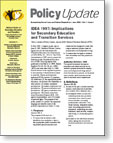 Policy
Updates Policy
Updates
Summarizing recent laws and federal regulations.
Youth with Disabilities and the Workforce Investment Act of 1998
NCSET Policy Update
• Volume 1 , Issue 2
This brief contains an overview of the Workforce Investment Act, workforce investment system management structures, and the One-Stop service system. It focuses on youth programs within WIA, and includes information about (a) funding structures and eligibility for youth activities, (b) Youth Opportunities Grants, (c) youth services and activities, (d) performance accountability, and (e) non-discrimination. This brief discusses implications for youth with disabilities in transition from school to work, and the wider benefits to workforce investment systems of effectively serving youth with disabilities.
IDEA 1997: Implications for Secondary Education and Transition Services
NCSET Policy Update
• Volume 1 , Issue 1
This revision of the National Transition Policy Update from January 2000 presents the regulatory language and potential implications in eleven areas of the 1997 Amendments to the IDEA pertaining to the transition of students from school to adult life. This brief is a great resource for parents, teachers, administrators, and community service providers.
^ Top of Page ^
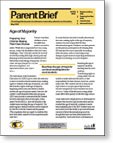 Parent
Briefs Parent
Briefs
Promoting effective parent involvement in secondary education
and transition.
(Co-produced by PACER
Center, a NCSET partner)
The Role of Parents in Dropout Prevention: Strategies that Promote Graduation and School Achievement (July 2006)
NCSET Parent Brief
Students who drop out of school face a difficult future. For students with disabilities, the risks are intensified. Their dropout rate is about 40 percent--more than twice that of their peers without disabilities. However, families can play an important role in making sure their student with or without disabilities graduates. Staying involved in your teen's life during middle school and high school is critical. This Brief provides information and practical tips to help parents do this.
What does Health Have to Do with Transition? Everything! (May 2006)
NCSET Parent Brief
This Parent Brief provides information on the benefits of and strategies for including health in the Individualized Education Program (IEP) process.
Preparing for Employment: On the Home Front (March 2006)
NCSET Parent Brief
This brief describes ways in which youth and families can help youth effectively explore work-based learning outside of school settings.
Universal Design for Learning and the Transition to a More Challenging Academic Curriculum: Making it in Middle School and Beyond (April 2005)
NCSET Parent Brief
This brief describes universal design, a process for creating environments that support the learning of students with diverse abilities, styles, and needs. In universal design, versatility is built into the environment from the start. Further resources are also provided.
Person-Centered Planning: A Tool for Transition (February 2004)
NCSET Parent Brief
This brief provides a concise description of person-centered planning and an explanation of the benefits of this process. The brief also provides action steps for implementing person-centered planning, references within the Individuals with Disabilities Education Act that support the process, and a list of additional resources. See Spanish Version of this Parent Brief.
Supplemental Security Income (Part 3 of 3): Your Right to Appeal (September 2003)
NCSET Parent Brief
This brief guides parents through the Supplemental Security Income appeals process, providing information about why many applications are denied, how the decisions are made, and how applicants can respond effectively. The brief provides detailed information about the four levels of appeal and discusses three case studies.
Supplemental Security Income (Part 2 of 3): So You Have Decided to Apply (April 2003)
NCSET Parent Brief
This parent brief is part 2 of a 3-part series on supplemental security income. The brief is tailored for parents of youth with disabilities and provides a detailed description of the process for applying for Supplemental Security Income (SSI). The brief outlines four elements, including a) the process of making an appointment with a Social Security Administration representative, b) the specific steps in applying for benefits, c) criteria that the Social Security Administration uses to determine an applicant's eligibility, and d) information about the evaluation conducted if the Social Security Administration cannot initially make a decision about your child's eligibility.
Supplemental Security Income (Part 1 of 3): A Bridge to Work (March 2003)
NCSET Parent Brief
This parent brief is part 1 of a 3-part series on supplemental security income. This brief gives parents of youth with disabilities practical information about how youth can use Social Security work incentives to facilitate a gradual transition from dependence on Supplemental Security Income (SSI) to partial or complete financial independence. Social Security work incentives allow a recipient of Supplemental Security Income to earn wages while maintaining SSI cash benefits and Medicaid. Background information, definitions, and specific financial criteria for using SSI work incentives are included.
IDEA 1997 Transition Issues: The IEP for Transition Aged Students (July 2002)
NCSET Parent Brief
This brief explains the requirements for transition under IDEA, the composition and functioning of the Individual Education Program (IEP) Transition Team, and special factors for the IEP Team to consider. It also outlines the roles of students, parents, educators, school staff, and agency staff on the IEP Transition Team. See Spanish Version of this Parent Brief.
Age of Majority: Preparing Your Child for Making Good Choices (May 2002)
NCSET Parent Brief
This brief stresses the importance of involving young people in setting their own high school goals and planning for their transition to adulthood. It outlines significant considerations parents face in helping their children reach the age of majority, including development of decision-making skills, understanding transfer of rights, and issues related to guardianship.
Parenting Postsecondary Students with Disabilities: Becoming the Mentor, Advocate, and Guide Your Young Adult Needs (March 2002)
NCSET Parent Brief
This brief focuses on the importance of involving parents in the transition from high school to the post-secondary environment, and provides concrete recommendations to help parents learn to mentor and advocate for their post-secondary youth. Includes parent resources and references. See Spanish Version of this Parent Brief.
National Center for Learning Disabilities-Parent Advocacy Brief: A Parent's Guide to RTI
NCSET Parent Brief
The National Center for Learning Disabilities (NCLD) is an invaluable web resource for parents. Their guide for understanding the Response-to-Intervention (RTI) process is currently used to determine special education eligibility. RTI is a tiered process designed to pair high quality instruction with research-based interventions in order to appropriately identify students in need of more individualized instruction. The guide contains comprehensive examples of RTI, glossary of educators’ terms, interview with an assistant superintendent experienced in RTI models, and list of questions that parents can ask their child’s school regarding its RTI process. Available in pdf (14 pages, 458 KB).
^ Top of Page ^
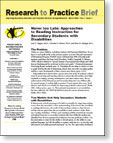 Research
to Practice Briefs Research
to Practice Briefs
Improving secondary education and transition services through
research.
Programs and Practices for Special Education Students in Alternative Education Settings (January 2007)
NCSET Research to Practice Brief
• Volume 6 , Issue 1
This brief shares some findings from the University of Oregon’s descriptive study, "What do they do there? Examination of alternative education schools, programs, and practices for special education students."
Creating Environments That Work for All Youth: Increasing the Use of Evidence-Based Strategies by Special Education Teachers (December 2006)
NCSET Research to Practice Brief
• Volume 5 , Issue 1
With a goal of increasing the use of evidence-based practices in special education programs and improve student outcomes, a research demonstration project was developed through a unique partnership of special educators, parents, administrators, and investigators. This brief reports on the method, implementation, and initial findings from this project.
What Algebra and Biology Students Have to Say About Universal Design for Learning (October 2005)
NCSET Research to Practice Brief
• Volume 4 , Issue 2
This brief outlines the findings of a study of whether universal design for learning (UDL) improves how students with mild disabilities perform in general education. The study's findings illustrate how students perceive individual interventions anchored by three key UDL principles--multiple ways of representing course content, multiple options for student expression and control, and multiple options for engagement and motivation. These individual interventions were used in standard-track high school algebra and biology classes.
Transition Planning: Community Mapping as a Tool for Teachers and Students (April 2005)
NCSET Research to Practice Brief
• Volume 4 , Issue 1
Community mapping can acquaint teachers and students with a community's culture, resources, transition needs, and assets. This brief describes the research base for community mapping and provides an outline of the roles, responsibilities, and materials involved in the community mapping process. It also provides examples and further resources for engaging in community resource mapping.
Increasing School Completion: Learning from Research-Based Practices that Work (August 2004)
NCSET Research to Practice Brief
• Volume 3 , Issue 3
This brief identifies and describes five research-based practices proven effective in increasing rates of school completion. The practices utilized random samples or comparison groups and had statistically significant results for the treatment group on the variable of enrollment status.
Building Bridges Toward Science Careers for Youth with Disabilities (April 2004)
NCSET Research to Practice Brief
• Volume 3 , Issue 2
This brief outlines results of a research project designed to (a) create a model facilitating greater access for students with disabilities to postsecondary education and careers in science and technology, and (b) investigate issues related to the transition from high school to college for students with disabilities. The researchers sought to gather information to promote a seamless transition for high school students with disabilities to math, science, engineering, and technology education at community colleges.
An Effective Model for College Students With Learning Disabilities and Attention Deficit Hyperactivity Disorders (February 2004)
NCSET Research to Practice Brief
• Volume 3 , Issue 1
College students with learning disabilities and attention deficit hyperactivity disorders who participate in the Virginia Commonwealth University Supported Education Model tend to stay in school and progress in their educational programs, according to a study conducted by the Virginia Commonwealth University Rehabilitation Research and Training Center on Workplace Supports. This brief describes the VCU Supported Education Model and results of the study.
Teaching for Understanding (November 2003)
NCSET Research to Practice Brief
• Volume 2 , Issue 4
While traditional lectures, exercises, and drills may help students memorize facts and formulas and get the right answers on tests, this time-honored style of teaching does not help students achieve the depth of understanding they need to understand complex ideas and apply knowledge in new settings or situations. This Research to Practice Brief outlines research regarding an approach called “teaching for understanding,” which strives to engender in students a depth of understanding on academic topics that enables them to apply the knowledge in various settings. Suggestions and resources for application of this approach are also provided.
DO-IT: Helping Students With Disabilities Transition to College and Careers (September 2003)
NCSET Research to Practice Brief
• Volume 2 , Issue 3
Summarizes research on outcomes for students with disabilities in postsecondary school and describes one program, DO-IT Scholars, that successfully applies research findings in a cohesive set of interventions for students who have disabilities. The brief also shares lessons that can be applied to other college and career preparation programs for youth with disabilities.
High Schools With Authentic and Inclusive Learning Practices: Selected Features and Findings (July 2003)
NCSET Research to Practice Brief
• Volume 2 , Issue 2
This brief outlines the major findings of a research study conducted by the Research Institute on Secondary Education Reform (RISER) on authentic and inclusive learning practices at four high schools. Authentic learning practices involve students in using disciplined inquiry to construct in-depth knowledge for themselves and others, and inclusive learning refers to the use of developmentally and individually appropriate accommodations and supports. The brief also discusses the implications and challenges presented by the study's findings.
Self-Determination: Supporting Successful Transition (April 2003)
NCSET Research to Practice Brief
• Volume 2 , Issue 1
This brief outlines research on self-determination suggesting that youth with disabilities who actively direct their own lives are more likely to successfully transition into adult life. In addition, the brief
addresses development of self-determination skills and student-led Individualized Education Program meetings. Also included are descriptions and contact information for several self-determination curricula and helpful Web links.
Improving Word Identification Skills Using Strategic Instruction Model (SIM) Strategies (December 2002)
NCSET Research to Practice Brief
• Volume 1 , Issue 4
This brief, written for general education teachers, special education teachers, and school administrators, focuses on the Word Identification Strategy component of the Strategic Instruction Model (SIM), (Deshler & Schumaker, 1988), and reviews recent research showing the effectiveness of this strategy for teaching word decoding to secondary students with disabilities. The brief includes examples of how the strategy works, plus additional resources.
Tapping Employment Opportunities for Youth with Disabilities by Engaging Effectively with Employers (December 2002)
NCSET Research to Practice Brief
• Volume 1 , Issue 3
This brief addresses studies that explore employer perspectives on managing supports and accommodations for youth with disabilities, and the implications of these studies for transition practice and employment services for youth with disabilities. Examining employer perceptions of hiring and accommodating individuals with disabilities is an important consideration in making work-based learning opportunities available to youth with disabilities. Further resources are included.
Collaborative Strategic Reading (CSR): Improving Secondary Students’ Reading Comprehension Skills (July 2002)
NCSET Research to Practice Brief
• Volume 1 , Issue 2
In this Research to Practice Brief, specifics of Collaborative Strategic Reading (CSR) implementation in the classroom are described, with references to further resources. CSR is a method of teaching reading comprehension that is effective with struggling readers, including secondary-age students with learning disabilities and those who are English Language Learners.
Never Too Late: Approaches to Reading Instruction for Secondary Students with Disabilities (January 2002)
NCSET Research to Practice Brief
• Volume 1 , Issue 1
This brief addresses the problem of lack of reading proficiency in children, including students with disabilities, in the primary grades. In this brief, two approaches for improving the reading skills of secondary students with learning disabilities are explored.
^ Top of Page ^
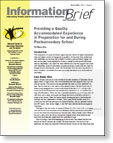 Information
Briefs Information
Briefs
Addressing trends and developments in secondary education and
transition.
Foster Youth Who Have Succeeded in Higher Education: Common Themes (April 2008)
NCSET Information Brief
• Volume 7 , Issue 1
All young people, including foster youth and youth with disabilities, can succeed academically given adequate support and advocacy from educators, professionals, and their caregivers. Casey Family Programs interviewed eight former foster youth who recently graduated from college. Their perspectives on going to college and obtaining a degree despite numerous barriers presents an opportunity learn how other young adults like them might be better supported.
Models of Collaboration and Cost Sharing in Transition Programming (January 2007)
NCSET Information Brief
• Volume 6 , Issue 1
This brief describes two funding tools that are increasingly used in collaborative relationships. Both blended funding and braided funding pool financial resources to maximize outcomes. These tools can help maintain and sustain effective relationships in transition programming.
Transition Services for Students Aged 18-21 with Intellectual Disabilities in College and Community Settings: Models and Implications of Success (December 2006)
NCSET Information Brief
• Volume 5 , Issue 5
This brief provides an overview of some successful models of transition services being implemented in postsecondary settings, describes one such model implemented by the Baltimore City Public School System in three local colleges, and presents some of the implications and strategies for success of this model.
Creating an E-Mentoring Community (August 2006)
NCSET Information Brief
• Volume 5 , Issue 4
This brief, written by Sheryl Burgstahler of the University of Washington's DO-IT program, provides an example of how to create and sustain an e-mentoring community to promote the success of youth with disabilities in school, careers, and other life experiences.
Youth Leadership Forums—Providing Leadership Development Opportunities for Youth with Disabilities (March 2006)
NCSET Information Brief
• Volume 5 , Issue 3
This brief outlines findings of youth development research, describes the components and benefits of Youth Leadership Forums (YLFs), and introduces the Iowa and Kansas YLFs.
The Voices of Youth: Perspectives and Recommendations from Young Adults Involved in Juvenile Corrections (February 2006)
NCSET Information Brief
• Volume 5 , Issue 2
This brief describes two exceptional programs for adjudicated youth with disabilities. It also includes commentary and recommendations from three young adults who live at the residential facilities where these programs are being implemented.
Choices in Transition: A Model for Career Development (February 2006)
NCSET Information Brief
• Volume 5 , Issue 1
This brief describes the Choices in Transition program for low-income ethnic minority youth with disabilities in Chicago. The program supports these youth in the process of transition in order to improve their educational and vocational success and increase their self-determination. Recommendations for improving the transition outcomes of youth with disabilities are included.
Enhancing Academic Achievement and Transition Outcomes Using Technology (September 2005)
NCSET Information Brief
• Volume 4 , Issue 5
It is critical that innovative curricula emerge that combine standards-based academics with transition planning to facilitate access to general education, including multiple-outcome measures and learning supports. In response to this challenge, the Nisonger Center at Ohio State University (OSU) developed a standards-driven, computer-based curriculum for students with disabilities in grades 8 through 10. This brief describes the curriculum and the principles behind it.
Professional Development for Transition Personnel: Current Issues and Strategies for Success (August 2005)
NCSET Information Brief
• Volume 4 , Issue 4
After more than two decades of federal transition legislation, students with disabilities continue to have significantly poorer postschool outcomes as compared to their peers without disabilities. One reason for these outcomes is that educators are inadequately prepared to provide the services required under the Individuals with Disabilities Education Act (IDEA). This brief provides an overview of critical issues related to transition professional development and highlights current models of improving results for youth by supporting practitioners with in-service and pre-service training.
Communities of Practice: A Strategy for Program Improvement (August 2005)
NCSET Information Brief
• Volume 4 , Issue 3
This Information Brief defines Communities of Practice, outlines seven principles essential for development of vibrant Communities of Practice, and offers examples. Further resources are also suggested.
High School Graduation Requirements and Students with Disabilities (February 2005)
NCSET Information Brief
• Volume 4 , Issue 2
An increasingly common graduation requirement for secondary schools is a passing score on an exit examination. This brief outlines issues and controversies surrounding the use of exit examinations, including the reasons proponents support the use of such exams. The brief also lists some of the intended and unintended consequences of using such exams.
Diploma Options for Students with Disabilities (February 2005)
NCSET Information Brief
• Volume 4 , Issue 1
Diploma options represent alternative means of graduating from high school. This brief outlines the different types of diploma options, discusses the benefits of systems with single diploma options and those with multiple diploma options, and provides information about further resources on the topic.
Alternative Schools and Students With Disabilities: Identifying and Understanding the Issues (October 2004)
NCSET Information Brief
• Volume 3 , Issue 6
This brief outlines the responses of state directors of special education to a telephone survey about major issues regarding students with disabilities and alternative schools in their states. Resources for further information are also provided.
Teaching Social Skills (October 2004)
NCSET Information Brief
• Volume 3 , Issue 5
This brief outlines the importance of social skills education for youth with disabilities, identifies specific skills needed by youth, provides guidance for choosing and implementing social skills programs, and offers information about creating a positive school climate that fosters the development of social skills.
Social Security and Undergraduates with Disabilities: An Analysis of the National Postsecondary Student Aid Survey (October 2004)
NCSET Information Brief
• Volume 3 , Issue 4
This brief provides a rich demographic profile of the utilization of postsecondary education by recipients of Social Security Income (SSI) and Social Security Disability Insurance (SSDI). The brief summarizes the results of the National Postsecondary Student Aid Survey and also provides information about resources for further information.
Motivating Youth with Disabilities to Learn in the Science Classroom (April 2004)
NCSET Information Brief
• Volume 3 , Issue 3
This brief provides teachers with strategies for motivating students with diverse learning styles, including students with disabilities, in science courses and programs. These strategies include use of case studies, analogies, lab-based education, storytelling, modeling, and role-playing. The brief also includes resources for further study.
Supporting Dynamic Development of Youth with Disabilities During Transition: A Guide for Families (March 2004)
NCSET Information Brief
• Volume 3 , Issue 2
This brief offers concrete, useful information about adolescent development to guide families in supporting youth with disabilities. It also provides the compassionate perspective of a parent of a youth with a disability regarding the transition process. Finally, the brief offers a list of further resources.
Addressing the Needs of Culturally and Linguistically Diverse Students With Disabilities in Postsecondary Education (February 2004)
NCSET Information Brief
• Volume 3 , Issue 1
Persons with disabilities usually must overcome a variety of challenges not faced by their peers without disabilities in order to gain entry to and succeed in postsecondary education. These challenges are often especially difficult for persons with disabilities of culturally and linguistically diverse heritage. This brief identifies the major challenges of postsecondary education for persons with disabilities of culturally and linguistically diverse heritage and provides recommendations to postsecondary institutions for supporting the educational success of these students.
Work-Based Learning and Future Employment for Youth: A Guide for Parents and Guardians (October 2003)
NCSET Information Brief
• Volume 2 , Issue 2
Setting high expectations early in life is an important step in order for
youth to develop the skills to succeed in the future. This guide for parents
and guardians of youth with disabilities outlines how work-based learning
helps youth identify interests, strengths, skills, and needs related to
career development. Specific examples are provided, as well as further
resources.
Community Resource Mapping: A Strategy for Promoting Successful Transition for Youth with Disabilities (April 2003)
NCSET Information Brief
• Volume 2 , Issue 1
This brief introduces a dynamic process for creating synergistic community collaboration among those concerned with youth development, and for maximizing the community's human and financial resources that support youth. The brief includes a detailed explanation of Community Resource Mapping, a list of the benefits of mapping, examples of mapping efforts, whom to contact information for further information, plus related resources.
Addressing the Transition Needs of Youth with Disabilities Through the Workforce Investment Act (WIA) System (December 2002)
NCSET Information Brief
• Volume 1 , Issue 6
This brief discusses strategies for including work-based learning and youth development opportunities sponsored by the Workforce Investment Act in students’ IEPs. The brief also addresses youth development, youth employment, and how One Stop career centers can be accessed to support students with disabilities in their career development. Additional resources are included.
What is Quality Education? Perspectives from Two Students and a Parent (December 2002)
NCSET Information Brief
• Volume 1 , Issue 5
The brief presents views on quality education from two individuals with disabilities and a parent of a youth with a disability. The authors offer rich and diverse views on how educational systems can best serve youth with disabilities.
Integrating Service Systems at the Point of Transition for Youth with Significant Disabilities: A Model that Works (December 2002)
NCSET Information Brief
• Volume 1 , Issue 4
This brief focuses on coordination and integration of various services (e.g. education, vocational rehabilitation, developmental disabilities) so that youth with disabilities receive continued support to maintain and expand their employment and independent living outcomes throughout adulthood, in addition to accessing other community activities. This brief describes a “blended” service model that addresses this concern. It features a case study example, and discusses implications for implementing similar models in individual schools and developmental disabilities service systems. Additional resources are included.
Universal Design for Learning: A Strategy to Support Students' Access to the General Education Curriculum (December 2002)
NCSET Information Brief
• Volume 1 , Issue 3
This brief describes principles of Universal Design and provides information about Universal Design resources. Universal Design refers to the design of flexible classroom materials and activities, including use of technology, to facilitate the achievement of learning goals by students with widely varying abilities.
Bridging the Digital Divide in Post-Secondary Education: Technology Access for Youth with Disabilities (December 2002)
NCSET Information Brief
• Volume 1 , Issue 2
This brief was designed for secondary and postsecondary educators and administrators, employers, individuals with disabilities, and parents. It outlines the challenges youth with disabilities face in gaining access to technology, and provides specific recommendations for achieving greater technology access. Computer access has the potential to help people with disabilities complete coursework independently, participate in class discussions, communicate with peers and mentors, access distance learning courses, participate in high tech careers, and lead self-determined lives.
Providing a Quality Accommodated Experience in Preparation for and During Postsecondary School (March 2002)
NCSET Information Brief
• Volume 1 , Issue 1
This brief provides clarification regarding the difference between meeting minimal standards for accommodation in postsecondary school, and providing a quality educational experience including accommodations. The brief includes a case example to illustrate the challenges youth with disabilities face without appropriate accommodations. Additional resources are also provided.
Pathways to College Network: Community Engagement Key to College-Going

NCSET Information Brief
This Pathways to College Network brief provides information on how best to target the various community audiences of a college access marketing campaign. Community involvement is vital in any college access marketing campaign, yet many campaigns neglect it. Outreach and engagement within a community change the college-going behaviors of students. All events, presentations, outreach, partnerships and publications should be strategized and leveraged into a comprehensive community engagement plan. Available in PDF (6 pages, 103 KB).
Measuring and Improving the Effectiveness of High School Teachers
NCSET Information Brief
This brief from the Alliance for Excellent Education defines teacher effectiveness at the high school level, explores different ways of measuring teacher effectiveness, and discusses how to use these measures to improve teaching and learning.
Youth Governance Can Help Out-Of-School Time Programs Involve At-Risk Youth

NCSET Information Brief
Children and youth who are the most “at risk” are also the least likely to participate in out-of-school programs. A new Child Trends brief, “Youth Governance: How and Why It Can Help Out-Of-School Time Programs Involve At-Risk Youth”, discusses the benefits of involving at-risk youth in out-of-school time program governance and steps to consider when implementing a youth governance model. The brief also includes advice from a program director who has involved youth in governance and a guide to additional resources. Available in pdf (9 pages, 196 KB).
AISR: Beating the Odds: How Thirteen NYC Schools Bring Low-Performing Ninth-Graders to Timely Graduation and College Enrollment
NCSET Information Brief
This report from the Annenberg Institute for School Reform describes a qualitative study of a small group of New York City high schools that are “beating the odds” by producing higher than predicted graduation and college-going rates for ninth-graders who entered with far below-average eighth-grade reading and math scores. The study identified four key strategies: academic rigor, networks of timely supports, college expectations and access, and effective use of data.
National High School Center Briefs for Practitioners (August 2008)
NCSET Information Brief
The National High School Center has released a set of briefs by MDRC consultants Michael Bangser and Thomas J. Smith that examine what is known about educational interventions that help students prepare for postsecondary education and employment.
^ Top of Page ^
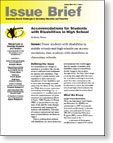 Issue
Briefs Issue
Briefs
Examining current challenges in secondary education and transition.
Youth with Disabilities in the Juvenile Justice System: Prevention and Intervention Strategies (February 2005)
NCSET Issue Brief
• Volume 4 , Issue 1
This brief provides proactive solutions to juvenile delinquency problems of all youth, including those with disabilities, involved in the juvenile justice system. In particular, the brief focuses on the models of restorative justice and wrap-around services. Information on additional resources is also provided.
Putting Interagency Agreements into Action (September 2004)
NCSET Issue Brief
• Volume 3 , Issue 2
Interagency agreements among educational and noneducational agencies can help maximize resources and services for transitioning youth. This brief describes the components of successful interagency agreements and how they can be implemented. Information about further resources is also provided.
The Emergence of Psychiatric Disabilities in Postsecondary Education (September 2004)
NCSET Issue Brief
• Volume 3 , Issue 1
An unprecedented and growing number of postsecondary students report psychiatric disabilities. This brief provides a brief definition of the issue and an outline of the primary barriers such students face in completing postsecondary education. The brief also offers strategies for postsecondary professionals, recommendations, and further resources.
Bullying and Teasing of Youth with Disabilities: Creating Positive School Environments for Effective Inclusion (December 2003)
NCSET Issue Brief
• Volume 2 , Issue 3
Bullying has been proven by numerous studies to be a serious problem nationwide. Harassment of youth with disabilities in particular has been steadily increasing. Whole school anti-bullying/anti-violence programs are necessary to address this problem effectively. This Issue Brief provides clear definitions of bullying, teasing, and disability harassment. It also outlines research about bullying and harassment, and describes two effective, comprehensive, whole-school, anti-bullying programs. Finally, the brief offers recommendations and resources for further action.
Quality Work-Based Learning and Postschool Employment Success (September 2003)
NCSET Issue Brief
• Volume 2 , Issue 2
This brief highlights the benefits of work-based learning for youth with disabilities and outlines the elements of quality work-based learning. In addition, the brief provides selected evidence-based models of work-based learning and information on further resources.
Collaboration Between General and Special Education: Making it Work (July 2003)
NCSET Issue Brief
• Volume 2 , Issue 1
Special education and general education teachers nationwide now find they need to develop new skills and strategies to meet the challenges of providing access to the general curriculum for all students, including those with disabilities. This brief calls for greater collaboration between general and special education teachers as one strategy for facilitating this access. The brief outlines a five-step model for implementing collaborative relationships and provides further resources for practitioners.
Challenges in Coordinating and Managing Services and Supports in Secondary and Postsecondary Options (December 2002)
NCSET Issue Brief
• Volume 1 , Issue 6
Current practices and policies, including differences between youth and adult service delivery systems and the lack of interagency collaboration, complicate service coordination for youth with disabilities. This brief, written for secondary and postsecondary educational administrators, state policymakers, rehabilitation counselors, and researchers, identifies the barriers to successfully managing supports for individuals with disabilities, and provides recommendations for overcoming these barriers. It seeks to answer the question, “How can service coordination become more flexible, youth-centered, and culturally responsive?”
Supporting Youth with Disabilities to Access and Succeed in Postsecondary Education: Essentials for Educators in Secondary Schools (December 2002)
NCSET Issue Brief
• Volume 1 , Issue 5
This brief outlines the differences in assistance determination and provision encountered by youth with disabilities as they transition into postsecondary environments. It offers related recommendations on improving the transition process for youth with disabilities and addresses the importance of student inclusion in the Individualized Education Plan (IEP) process.
Creating Mentoring Opportunities for Youth with Disabilities: Issues and Suggested Strategies (December 2002)
NCSET Issue Brief
• Volume 1 , Issue 4
This brief addresses the need for expansion of mentoring opportunities for youth with disabilities. Specifically, the brief a) outlines some of the benefits of mentoring for youth, b) defines the issue of the need for expanded mentoring opportunities for youth with disabilities, and c) presents strategies for including youth with disabilities in mentoring programs.
Connecting Employers, Schools, and Youth Through Intermediaries (December 2002)
NCSET Issue Brief
• Volume 1 , Issue 3
This brief, written for secondary educators, employers, and disability service providers, addresses the primary issues in promoting the participation of employers in work-based learning experiences for youth with disabilities. In addition, it outlines strategies for how employers can more effectively engage youth with disabilities by working with intermediary organizations.
Students with Disabilities who Drop Out of School: Implications for Policy and Practice (July 2002)
NCSET Issue Brief
• Volume 1 , Issue 2
Using research-based information, this brief defines the problem of an unacceptably high dropout rate for students with disabilities and articulates proven intervention strategies. The brief addresses new school accountability policies and stiffer promotion and graduation requirements.
Accommodations for Students with Disabilities in High School (January 2002)
NCSET Issue Brief
• Volume 1 , Issue 1
This brief addresses the issue that fewer students with disabilities in middle schools and high schools use accommodations than students with disabilities in elementary schools. The brief reviews research findings, legal considerations, and needs for further research.
^ Top of Page ^
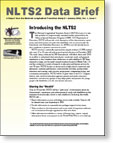 NLTS2
Data Briefs NLTS2
Data Briefs
Family Expectations and Involvement for Youth with Disabilities (September 2005)
NCSET NLTS2 Data Brief
• Volume 4 , Issue 2
The National Longitudinal Transition Study-2 (NLTS2) provides the first national picture of the involvement of families in the educational development of their secondary-school-age children with disabilities. This Data Brief describes family involvement at home and at school, including a comparison of levels of involvement for families of youth with disabilities with those for families in the general population. It also discusses involvement in a school-based activity that is specific to families of youth with disabilities: participation in individualized education program (IEP) meetings. Finally, parent expectations for their children's attainment of postsecondary education and independence are highlighted.
The Transition Planning Process (April 2005)
NCSET NLTS2 Data Brief
• Volume 4 , Issue 1
This NLTS2 Data Brief provides a national view of the transition planning process undertaken during high school with and for youth with disabilities as they prepare for life after school. The information reported comes from a mail survey of school personnel conducted as part of the National Longitudinal Transition Study-2 (NLTS2). Findings from NLTS2 generalize to youth with disabilities nationally who were 13 to 16 years old in December 2000, to each of 12 federal disability categories, and to each age group within the age range.
The Characteristics, Experiences, and Outcomes of Youth with Emotional Disturbances (August 2004)
NCSET NLTS2 Data Brief
• Volume 3 , Issue 2
This NLTS2 Data Brief takes a fresh look at selected characteristics of youth with emotional disturbances and their households that distinguish them from other youth with disabilities and/or from youth in the general population. It also describes aspects of their school histories and their current school programs and experiences, as well as indicators of their academic performance and social adjustment at school. Finally, the activities of youth with ED outside of school are highlighted.
Social Activities of Youth with Disabilities (March 2004)
NCSET NLTS2 Data Brief
• Volume 3 , Issue 1
This brief provides highlights of the results of the National Longitudinal Study-2 in regard to social activities of youth with disabilities. Researchers asked parents how often youth interact with friends by getting together outside of school, receiving telephone calls from them, and being invited to other youths' social activities. They also asked whether youth had taken part in various extracurricular activities during the previous year.
Youth Employment (December 2003)
NCSET NLTS2 Data Brief
• Volume 2 , Issue 2
This NLTS2 Data Brief provides a detailed description of employment trends for youth with disabilities documented within the National Longitudinal Study-2. The NLTS2 has recently gathered data on work-study employment and regular paid employment of youth with disabilities, with a focus on hourly pay, disability categories, demographic differences in employment, and individual differences such as gender, age, race/ethnicity, and household income in relation to employment. This brief provides a concise and organized presentation of the results, including descriptive graphs.
Who Are Secondary Students in Special Education Today? (June 2003)
NCSET NLTS2 Data Brief
• Volume 2 , Issue 1
This report of the demographic characteristics of youth with disabilities
participating in the National Longitudinal Study-2 provides important
information about factors other than disability that affect the educational
and transition experiences of youth with disabilities.
Introducing the NLTS2 (January 2002)
NCSET NLTS2 Data Brief
• Volume 1 , Issue 1
This introductory NLTS2 Data Brief is the first in a series that will highlight the major findings and results of this transition study of youth with disabilities. This issue describes the NLTS2 project.
^ Top of Page ^
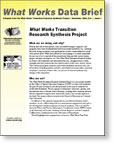 What
Works Data Briefs What
Works Data Briefs
Reports from the What Works Transition Research Synthesis Project.
(Co-produced by the What Works Transition Research
Synthesis Project)
What Works Transition Research Synthesis Project (December 2002)
NCSET What Works Data Brief
• Volume 1 , Issue 1
This introductory What Works Data Brief provides information about the project, its goals, and what readers can look forward to in terms of future reports and presentations.
^ Top of Page ^
View Other Publications Pages
^ Top of Page ^
|
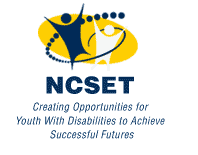
 Policy
Updates
Policy
Updates Parent
Briefs
Parent
Briefs Research
to Practice Briefs
Research
to Practice Briefs Information
Briefs
Information
Briefs Issue
Briefs
Issue
Briefs NLTS2
Data Briefs
NLTS2
Data Briefs What
Works Data Briefs
What
Works Data Briefs